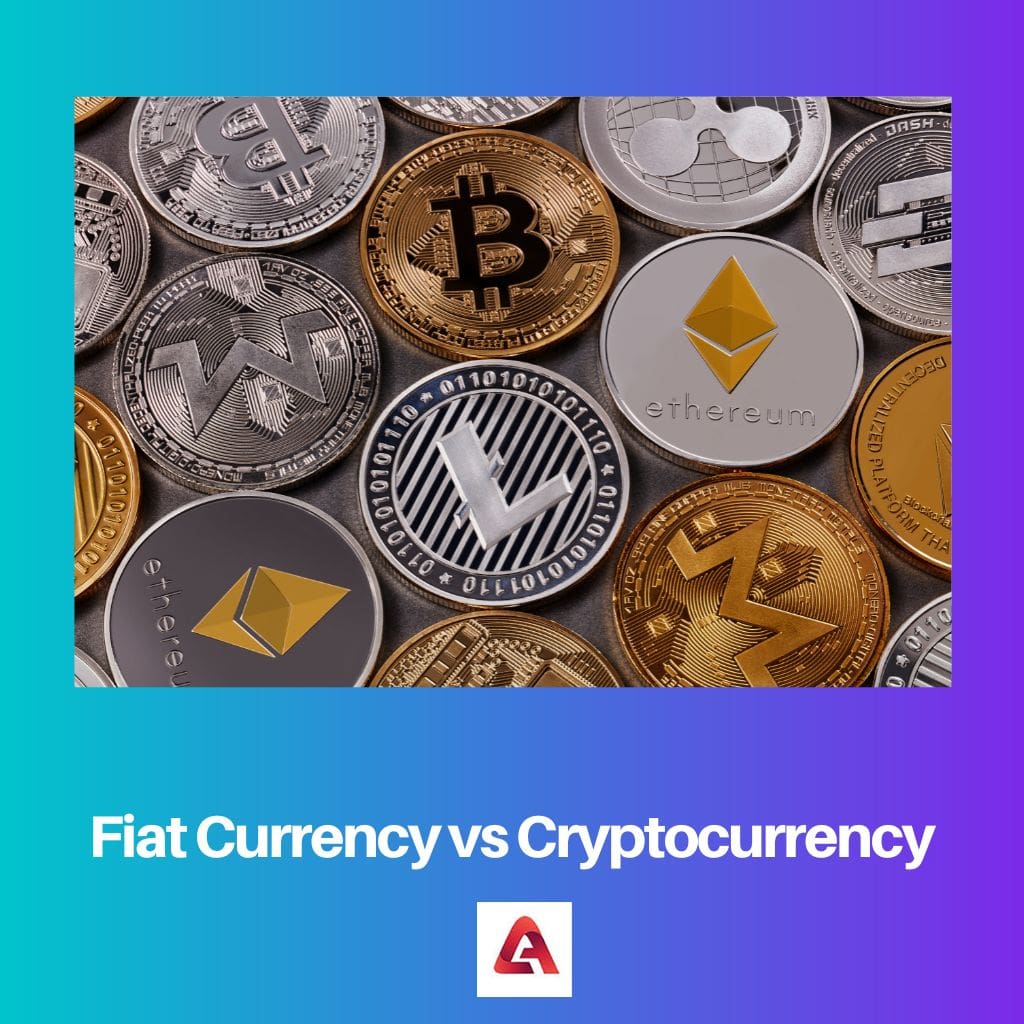Fiat currency, backed by governments, relies on centralized authorities for issuance and regulation, offering stability but vulnerable to inflation and manipulation. Cryptocurrency, decentralized and based on blockchain technology, offers transparency, security, and potential for financial autonomy, yet faces volatility and regulatory uncertainties.
Key Takeaways
- Fiat currency is a government-issued and regulated form of money whose value is derived from the trust and confidence in the issuing government; cryptocurrency is a decentralized digital or virtual currency secured by cryptography and not regulated by a central authority.
- Fiat currencies are managed by central banks, which control monetary policy and maintain price stability; cryptocurrencies operate on blockchain technology, which provides a decentralized and transparent ledger for transactions.
- Both fiat currency and cryptocurrency serve as mediums of exchange, but fiat currency is backed by a government authority, while cryptocurrency relies on cryptographic security and decentralized networks.
Fiat Currency vs Cryptocurrency
The difference between fiat currencies and cryptocurrencies is that the issuer and receiver of the fiat currency transactions can easily be tracked and identified. In contrast, in cryptocurrency, transactions are computerized and enciphered, and the issuer and receiver’s cash identification remains obscured.

Fiat currencies are officially sanctioned coins, printed in traditional paper form, which play an essential role in socio-economy by acting as a legal tender and are not backed by a solid item/object, like gold, but instead by the government that sanctioned it and is administered by a centralized authority (e.g., Federal Reserve banks or central banks). Fiat money, like Pounds, US dollars, euros, Yen, and other major worldwide currencies, attain their monetary value from market demand and supply forces.
On the other hand, a digital or virtual form of currency like cryptocurrency is an alternative to conventional payment methods like money, master cards, and bank checks. Cryptocurrency is not backed by the government, not regulated by any centralized authority, operates as a circulating medium, and is established on cryptanalysis mechanization to help undertake stable, assured and certified dealings/proceedings.
Comparison Table
| Feature | Fiat Currency | Cryptocurrency |
|---|---|---|
| Issuing Body | Governments or central banks | Decentralized (no single issuing body) |
| Form | Physical (coins, bills) and digital (electronic transfers) | Digital only |
| Regulation | Regulated by governments and central banks | Largely unregulated, but regulations are evolving |
| Value Determination | Backed by the issuing government’s economy and faith; influenced by supply and demand | Determined by supply and demand, market forces, and speculation |
| Stability | Generally considered more stable, but can be subject to inflation and devaluation | Highly volatile, prices can fluctuate significantly |
| Security | Relied on government protection and physical security measures | Secured by cryptography and distributed ledger technology (blockchain) |
| Transactions | Can be conducted physically or electronically, but may involve intermediaries like banks | Primarily conducted electronically, peer-to-peer, without intermediaries |
| Accessibility | Widely accepted by merchants and used for everyday transactions | Not as widely accepted as fiat currency, but adoption is growing |
| Anonymity | Transactions are generally traceable | Some cryptocurrencies offer a degree of anonymity, but regulations are increasing transparency |
What is Fiat Currency?
Fiat Currency: An Overview
Fiat currency is a type of currency that is issued by a government and declared to be legal tender, but is not backed by a physical commodity like gold or silver. Instead, its value is derived from the trust and confidence of the people who use it. Here’s a detailed breakdown:
Definition and Characteristics
Fiat currency derives its value from the faith and credit of the government that issues it rather than from any intrinsic value. It is typically in the form of paper money or coins, and its value is determined by supply and demand in the market. Unlike commodity money, such as gold or silver coins, fiat currency has no inherent value of its own.
Issuance and Regulation
Governments have the authority to issue and regulate fiat currency through their central banks or monetary authorities. They control the supply of money in circulation through mechanisms like interest rates, reserve requirements, and open market operations. Central banks also play a crucial role in maintaining price stability and managing inflation to ensure the currency’s purchasing power remains relatively stable over time.
Advantages and Disadvantages
Fiat currency offers several advantages, including widespread acceptance, liquidity, and stability backed by the government’s authority. It facilitates economic transactions, fosters trade, and provides a reliable medium of exchange. However, fiat currencies are susceptible to inflation, devaluation, and manipulation by governments or central banks for political or economic purposes. Additionally, reliance on centralized authorities for issuance and regulation can raise concerns about transparency and accountability.

What is Cryptocurrency?
Cryptocurrency: An Overview
Cryptocurrency is a digital or virtual form of currency that utilizes cryptography for secure and decentralized transactions. It operates independently of a central authority, such as a government or financial institution, and is based on blockchain technology. Here’s a comprehensive breakdown:
Definition and Characteristics
Cryptocurrency is a type of digital asset that uses cryptographic techniques to secure financial transactions, control the creation of new units, and verify the transfer of assets. Unlike traditional currencies, cryptocurrencies operate on decentralized networks, typically based on blockchain technology. Each cryptocurrency unit is recorded on a distributed ledger, ensuring transparency and immutability of transactions. Examples include Bitcoin, Ethereum, and Ripple.
Decentralization and Blockchain Technology
Cryptocurrencies are decentralized systems, meaning they operate without a central authority or single point of control. Transactions are verified and recorded on a blockchain, a distributed ledger maintained by a network of computers (nodes) spread across the globe. Blockchain technology ensures transparency, security, and immutability by cryptographically linking each block of transactions to the previous one, making it nearly impossible to alter historical records.
Advantages and Disadvantages
Cryptocurrencies offer several advantages, including privacy, security, low transaction fees, borderless transactions, and financial sovereignty. They empower individuals to have full control over their assets without the need for intermediaries, such as banks or payment processors. Additionally, cryptocurrencies enable innovative applications, such as smart contracts and decentralized finance (DeFi), which can potentially revolutionize various industries.
However, cryptocurrencies also pose certain challenges and risks. These include price volatility, regulatory uncertainty, scalability issues, susceptibility to hacking and fraud, and environmental concerns due to energy-intensive mining processes. Moreover, the lack of widespread adoption and user-friendly interfaces can hinder mainstream acceptance and usability of cryptocurrencies for everyday transactions.

Main Differences Between Fiat Currency and Cryptocurrency
- Here are the main differences between fiat currency and cryptocurrency in a bullet point list:
- Centralization:
- Fiat currency is centralized, controlled, and regulated by governments or central banks.
- Cryptocurrency is decentralized, operating on peer-to-peer networks without central authority.
- Backing:
- Fiat currency is typically backed by the government’s trust and authority, with no intrinsic value.
- Cryptocurrency may have intrinsic value through its underlying technology and network, such as blockchain, but lacks physical backing like gold or silver.
- Issuance and Regulation:
- Fiat currency issuance and regulation are controlled by central authorities, with policies influenced by monetary policies and economic conditions.
- Cryptocurrency issuance and regulation are decentralized and governed by consensus mechanisms within the respective blockchain networks.
- Transparency and Privacy:
- Fiat currency transactions are relatively transparent to regulatory authorities, with limited privacy for users.
- Cryptocurrency transactions are pseudonymous and offer varying degrees of privacy, depending on the blockchain protocol used.
- Transaction Speed and Fees:
- Fiat currency transactions are processed through traditional banking systems, which can be slower and involve higher transaction fees, especially for international transfers.
- Cryptocurrency transactions can be faster and have lower fees, particularly for cross-border transactions, although this depends on the specific cryptocurrency and network congestion.
- Volatility and Stability:
- Fiat currencies generally exhibit lower volatility and offer stability backed by government policies and economic stability.
- Cryptocurrencies often experience higher volatility due to speculative trading, market sentiment, and relatively small market sizes compared to fiat currencies.
- Acceptance and Adoption:
- Fiat currency is widely accepted as legal tender for goods and services globally, with established infrastructure for banking and financial transactions.
- Cryptocurrency acceptance and adoption vary widely, with some merchants and individuals accepting them for payments, but mainstream adoption is still limited in comparison to fiat currencies.
- Storage and Security:
- Fiat currency is typically stored in traditional bank accounts or physical cash, with security measures provided by banks and financial institutions.
- Cryptocurrency is stored in digital wallets and requires users to manage their private keys, providing greater control but also requiring robust security practices to prevent theft or loss.

- https://arxiv.org/pdf/1406.6496
- https://www.net.in.tum.de/fileadmin/TUM/NET/NET-2015-03-1/NET-2015-03-1_13.pdf
- https://openaccess.city.ac.uk/id/eprint/19829/1/

The in-depth analysis of this article is commendable. It’s essential to educate the public on the changing landscape of currency.
The comparison table makes it easy to understand the distinctions between fiat currency and cryptocurrency. It’s a comprehensive overview.
Absolutely. The table simplifies complex concepts, making it accessible for a wider audience.
The article offers a well-researched evaluation of fiat and cryptocurrency, shedding light on the complexities of modern money systems.
Agreed. The depth of analysis here is impressive and contributes to a better understanding of financial structures.
Absolutely. It’s a thought-provoking exploration of the changing dynamics in the financial sector.
Cryptocurrency is the future of finance – it’s time to embrace digital currencies and leave fiat behind.
I’m not so sure. While cryptocurrency has its benefits, it’s important to consider the risks and implications of a fully digital financial system.
This article presents a balanced view of fiat and cryptocurrency. It’s crucial to consider both perspectives in the evolving financial environment.
Definitely. It’s important to weigh the advantages and disadvantages of each currency type to make informed decisions.
This article provides a clear comparison between fiat and cryptocurrency, highlighting the key differences and advantages of each. It’s a great source for anyone looking to understand the global economy better.
I agree. It’s important to understand the fundamental differences between these two types of currency, especially in today’s digital economy.
Definitely worth the read. The world of finance is evolving rapidly, and this content provides valuable insights.
The discussion on fiat currency and cryptocurrency highlights the intricacies of modern money systems, offering compelling arguments for both sides.
Absolutely. It’s a pertinent exploration of the current financial landscape, raising important questions about the future of money.
The nuanced approach to comparing fiat and cryptocurrency in this article is both enlightening and thought-provoking. A must-read for anyone interested in global finance.
Absolutely. The critical analysis presented here provides valuable insights into the complexities of modern financial structures.
The historical context provided for fiat currency offers a comprehensive understanding of its development and implications. An enlightening read.
Definitely. Understanding the historical foundations of currency is essential to grasp its contemporary significance and potential evolution.
The article provides valuable insights into the nature of fiat and cryptocurrencies, from their regulation to storage and supply. A well-rounded assessment.